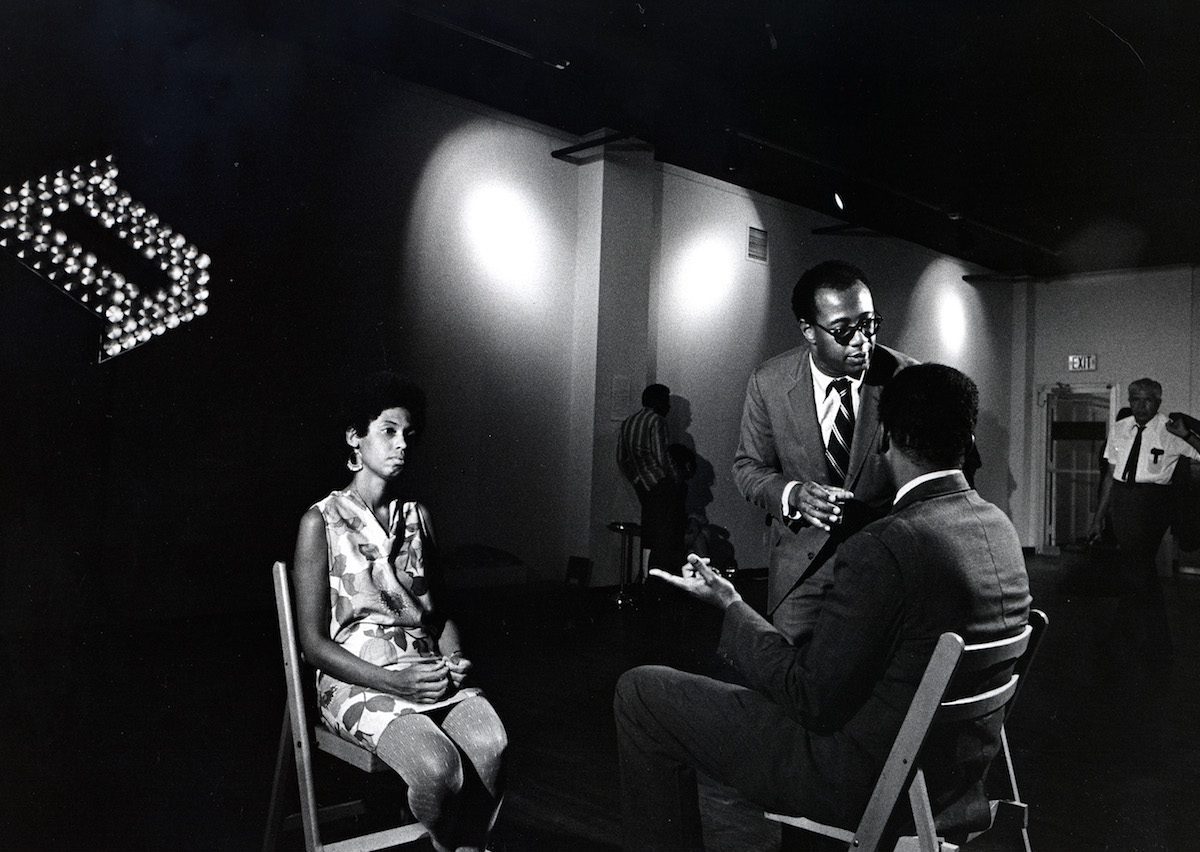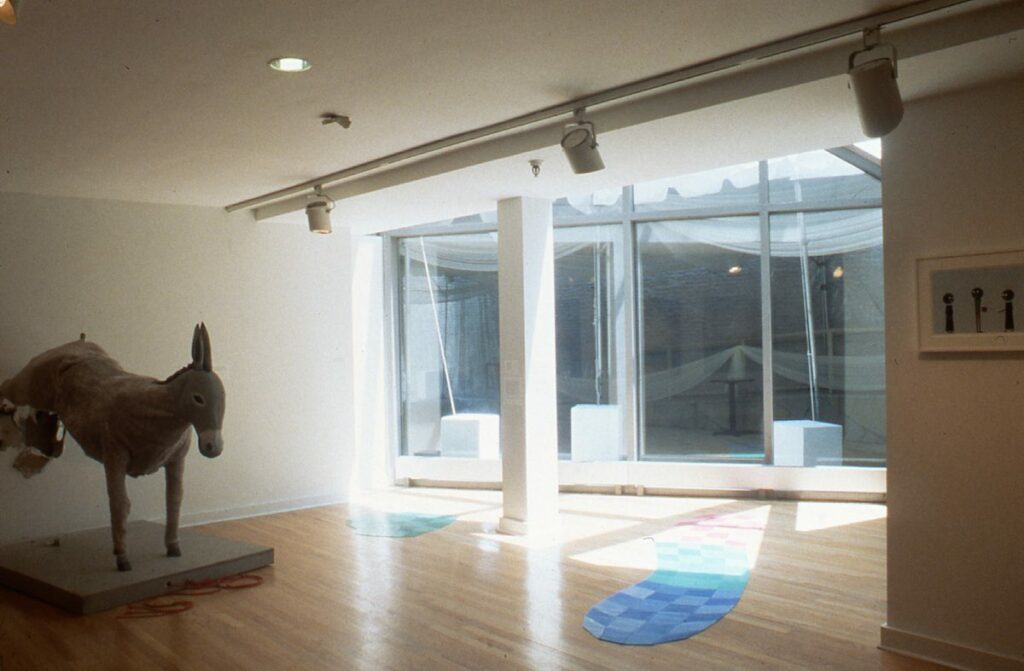Thelma Golden, directrice et conservatrice au Studio Museum à Harlem, s’entretient avec C& sur les premières années du musée, le dialogue qu’il a inspiré et son cinquantième anniversaire qui sera fêté en 2018.

At The Studio Museum’s 1968 exhibition, Tom Lloyd: Electronic Refractions II
C& : Vous êtes directrice et conservatrice en chef du Studio Museum à Harlem depuis 2000. Comment avez-vous démarré cette aventure ?
Thelma Golden : Ma relation avec le Studio Museum remonte à l’année 1985. À cette époque, alors que j’étais dans ma seconde année d’études au Smith College, j’ai eu la formidable opportunité de travailler à la fois dans le service de conservation et avec la directrice du musée, Mary Schmidt Campbell. Mme Campbell est une visionnaire et une pionnière de la culture, une sommité des arts et une historienne de l’art. Ce stage à ses côtés a véritablement posé les jalons de ma carrière dans l’univers des musées d’art. Lorsque j’ai obtenu mon diplôme en 1987, j’ai travaillé comme assistante à la conservation au Studio Museum pendant une année avant de travailler au Whitney Museum. Lorsque je suis revenue au Studio Museum en 2000, j’y avais déjà travaillé deux fois, pour deux directrices différentes, Mme Campbell et Kinshasha Holman Conwill. Je suis revenue en tant que sous-directrice et conservatrice en chef à l’invitation de la nouvelle directrice, Mme Lowery Stokes Sims, et j’ai succédé à Mme Sims comme directrice en 2006.
C& : Le Studio Museum a été fondé en 1968, au cœur du mouvement américain pour les droits civiques. Quel a été le rôle du musée à cette période ?
TG : J’ai eu l’occasion formidable de côtoyer des personnes qui avaient été impliquées dans la création du Studio Museum, des personnes qui étaient parties prenantes avant même l’ouverture de ses portes, ont imaginé le musée et ont travaillé pour qu’il voit le jour. L’idée du Studio Museum est allée de pair avec plusieurs autres idées et projets de l’époque. Lorsque je parle aux gens – dont de nombreux artistes – qui ont été impliqués dans le musée à ses débuts, ils disent s’être vus en train de créer un musée qui collectionnerait et présenterait des œuvres d’art, mais aussi une institution qui occuperait un rôle à part dans le développement d’une communauté.
C& : Comment la structure du musée et sa vision ont-elles évolué et changé depuis cette époque ?
TG : Je pense que ce qui fait que le Studio Museum reste un lieu aussi exceptionnel et intéressant, c’est qu’il a toujours évolué et réagi aux différentes époques du monde de l’art et de la culture. Il représente un témoignage incomparable pour toutes les femmes qui l’ont dirigé pendant la période où j’y ai travaillé. Ce musée a toujours été à la hauteur des débats du moment – allant parfois jusqu’à les mener, y réagissant d’autres fois, souvent les deux à la fois. Lorsque j’y étais à la fin des années 1980, Mme Campbell a soutenu avec une énergie extrême une histoire de l’art revue et corrigée, une réécriture d’une histoire mainstream qui avait tout bonnement exclu les contributions d’artistes d’origine africaine, ainsi que d’artistes latino-américains, asiatiques, de femmes, et de bien d’autres encore. Je suis très fière que cette institution contribue à réécrire l’Histoire en créant des expositions qui comblent les lacunes de celle-ci de diverses manières.
C& : Quel est le rôle actuel du Studio Museum en tant qu’espace social en rapport au climat très tendu à Ferguson, au cas Eric Garner, etc. ?
TG : Je pense qu’une institution doit fournir un cadre aux débats. L’expérience de l’art, l’inspiration et l’instigation dont l’art est à l’origine peuvent aider des personnes à se comprendre elles-mêmes et à comprendre le monde. Au Studio Museum, nous proposons des programmes formidables pour les jeunes gens, dont certains très innovants pour les lycéens, qui tournent autour de la création artistique, mais se servent aussi de cette création artistique comme d’un moyen de parvenir à la narration et au débat. Ainsi, lorsque les jeunes gens se découvrent et réfléchissent à leur place dans ce monde, l’art peut leur fournir la possibilité d’articuler et de développer leurs voix de manières très puissantes, en particulier lorsque des événements tumultueux se déroulent dans le monde qui nous entoure.
C& : Parlons de la propagation rapide du terme d’« art global ». Tout à coup, chaque musée ne veut plus se limiter à exposer Jeff Koons et Ed Atkins, mais souhaite aussi s’ouvrir à des perspectives de l’art non-occidental. Pourquoi une institution telle que le Studio Museum revêt une plus grande importance en ce moment ?
TG : Je ne pense pas que cette problématique soit aussi ambivalente. Je considère que la possibilité offerte aux artistes d’origine africaine d’exposer partout est fantastique. Je pense qu’il est également important de disposer de plateformes qui présentent la spécificité d’artistes d’origine africaine. Je me positionne clairement pour ces deux possibilités, pour que toutes les configurations existent.
C& : La collection permanente du Studio Museum regroupe près de 2 000 œuvres d’art. Pouvez-vous nous en dire un peu plus sur votre démarche concernant la collection ?
TG : Notre collection permanente regroupe tous les types de médias et s’étend du XIXe siècle à nos jours. Notre approche de la collecte d’œuvres d’art est très large, car nous cherchons à représenter et transmettre les histoires de l’incroyable palette d’artistes d’origine africaine. Mais en même temps, dans notre collection, nous cherchons aussi à explorer et présenter des idées et des expériences très spécifiques. À titre d’illustration, le Studio Museum tire son nom du programme fondateur Artist-in-Residence. Chaque année, nous accueillons trois artistes qui travaillent dans les studios du musée et nous les exposons à la fin de l’année. Nous acquérons des œuvres de ces artistes, de sorte que la collection est représentative des nombreux artistes qui ont travaillé ici et sont devenus parties intégrantes de notre communauté en participant à ce programme. Naturellement, nous acquérons aussi des œuvres de nos expositions. « Freestyle » (2001) a été la première édition de ce qui est devenu une sorte d’exposition collective signature de l’établissement, surnommée « F shows » (les « expos F ») qui correspondent aux expositions d’un groupe dynamique d’artistes émergents. Elle a été suivie de « Frequency » (2005), « Flow » (2008) et « Fore » (2012). Nous avons acquis des œuvres lors de chacune de ces expositions, et bien d’autres, de sorte que la collection reflète également l’histoire spécifique de nos expositions.

Freestyle (installation). The Studio Museum in Harlem, April 28 to June 24, 2001. Featuring work by (left to right): Eric Wesley, Louis Cameron, Laylah Ali
C& : En 2018, le musée fêtera son 50e anniversaire.
TG : Oui ! Nous sommes très excités à cette perspective et avons lancé plusieurs projets et programmes. Un projet essentiel auquel nous travaillons consiste à capturer les histoires des nombreuses personnes ayant été intimement impliquées dans l’histoire du musée depuis sa fondation, dont les divers directeurs, les commissaires, les artistes que nous avons exposés, et nos innombrables administrateurs, donateurs, membres et autres sympathisants. Ensuite, nous réfléchissons à un projet qui analyse spécifiquement ces cinquante années de réception, de collecte et de commissariat d’artistes d’origine africaine. Finalement, nous sommes en train de mettre sur pied un projet intitulé inHarlem, dérivé du nom du Studio Museum à Harlem. Il consiste en une série de projets publics in situ prévus dans le quartier. Pour notre anniversaire, nous souhaiterions créer des projets qui aient une incidence non seulement sur le quartier, mais qui en soient aussi une composante vitale.
Vendredi 15 Mai 16h: Frieze NY, Thelma Golden and Dr. Arnold Lehman, Director of the Brooklyn Museum in New York,
Propos recueillis par Julia Grosse
More Editorial